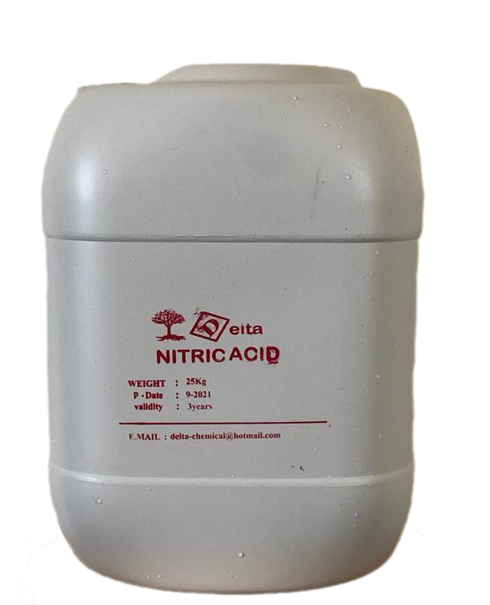Delta Industrial Development Company
Concentrated nitric acid3
Concentrated nitric acid3
Couldn't load pickup availability
Active Ingredients - Concentration
30% concentrated nitric acid
Category
Mixability
It is preferable to conduct a mixing experiment beforehand.
Characteristics – features
It is used as a source of nitrogen fertilizer, as it contains 15% nitrogen.
It is used to lower the acidity (pH) of irrigation water, thus preventing salt (fertilizer) deposition in the irrigation network.
It temporarily lowers the pH of the soil solution, thus helping the plant absorb nutrients from the soil.
-It helps release calcium from the soil, especially in calcareous soils, because it reacts with hard-to-soluble calcium carbonate, converting it into easily soluble calcium nitrate, which is easily absorbed by the plant.
In short, for those who have land that contains lime or clay, as you call it,
of course, this land is very rich in calcium, but it is not readily available to the plant. This means that the plant is unable to absorb it from the soil, just like if you were sitting by the sea, thirsty, and there was water in front of you, but you couldn't drink it because it was salty. Plants are exactly like humans.
Of course, when we add acid Nitric acid in these soils facilitates calcium absorption by the plant, thus facilitating its absorption.
It is added to fertilizers to increase their absorption, such as adding it with calcium nitrate.
It helps absorb calcium and prevents its fixation in the soil.
It is added with potassium sulfate fertilizer.
In this case, it helps convert potassium sulfate fertilizer into potassium nitrate, which is easily absorbed by the plant.
So, dear, if you are fertilizing with potassium sulfate (0-0-50), it is preferable to add nitric acid with it, as it converts a large portion of it into potassium nitrate, which is easily absorbed and also expensive if you buy ready-made potassium nitrate fertilizer.
In this case, (potassium sulfate fertilizer + nitric acid) should be added some time before fertilizing. So, if you are fertilizing in the morning, you can add it in the evening so that the nitric acid converts potassium sulfate into potassium nitrate.
It saves you money.
Nitric acid is also used. To reduce the acidity of saline soils, thus helping plants absorb nutrients added to the soil.
Important Warnings
1- Fertilizer shop owners and acid dealers should not store nitric acid near sulfuric acid.
The reason is:
Because, of course, a hole may occur in the nitric acid container or the sulfuric acid container.
If sulfuric acid reacts with nitric acid, an explosion may occur.
Toxic gases are released.
Please be extremely careful.
There are also farmers who bring calcium hydroxide, add nitric acid to it, and fertilize the soil with it. This is extremely dangerous.
This is because when nitric acid reacts with potassium hydroxide, a violent reaction occurs, an explosion occurs, and toxic gases are released.
Nitric acid should not be mixed with humic acid, because in this case, the humic acid does not dissolve and precipitates.
Nitric acid is considered... It is a toxic substance, so its vapors should not be inhaled or it should not come into contact with the skin or eyes.
Recommendations and usage rates
| 2:1 liter/hectare depending on the concentration of chickpeas and the type of crop. |
Pre-Harvest Interval (PHI)
0
Producing company (Brand)
Delta Industrial Development Company
Share


